Marketing in Travel and Tourism: Thomson, Spain Analysis Report
VerifiedAdded on 2020/07/23
|27
|8870
|51
Report
AI Summary
This report delves into the core concepts, principles, and roles of marketing within the travel and tourism sector, with a specific focus on Thomson's operations in Spain. The assignment explores the significance of marketing as a management tool, examining the impacts of the marketing environment, including micro and macro factors. The report analyzes market segmentation, consumer motivation, and the marketing mix elements, including product, price, place, and promotion. Furthermore, it evaluates the strategic marketing approaches relevant to both travel and tourism businesses and tourist destinations. The report also includes detailed holiday packages designed for different age groups, illustrating practical applications of marketing strategies. The analysis also discusses the integrated nature and role of promotional mix, and the impact of marketing on society.

MARKETING IN
TRAVEL AND
TOURISM
TRAVEL AND
TOURISM
Paraphrase This Document
Need a fresh take? Get an instant paraphrase of this document with our AI Paraphraser

TABLE OF CONTENTS
INTRODUCTION...........................................................................................................................1
TASK 1............................................................................................................................................1
1.1 Core concepts of Marketing for travel and tourism sector....................................................1
1.2 Impact of marketing environment on individual travel and tourism businesses...................3
1.3 Factors affecting the motivation and demand of consumer..................................................5
1.4 Principles and importance of market segmentation in marketing planning..........................6
TASK 2............................................................................................................................................7
2.1 Importance of strategic marketing in travel and tourism business and tourist destination.. .7
2.2 Relevance of marketing research and market information to managers...............................9
2.3 Impact of marketing on society...........................................................................................10
TASK 3..........................................................................................................................................11
3.1 Issues in the product, price and place elements of marketing mix......................................11
3.2 Importance of service sector mix elements to the travel and tourism sector......................12
3.3 Concept of total tourism product........................................................................................14
4.1 Integrated nature and role of promotional mix...................................................................15
4.2 Planning and Justification of an integrated promotional campaign....................................17
CONCLUSION..............................................................................................................................18
REFERENCES..............................................................................................................................22
INTRODUCTION...........................................................................................................................1
TASK 1............................................................................................................................................1
1.1 Core concepts of Marketing for travel and tourism sector....................................................1
1.2 Impact of marketing environment on individual travel and tourism businesses...................3
1.3 Factors affecting the motivation and demand of consumer..................................................5
1.4 Principles and importance of market segmentation in marketing planning..........................6
TASK 2............................................................................................................................................7
2.1 Importance of strategic marketing in travel and tourism business and tourist destination.. .7
2.2 Relevance of marketing research and market information to managers...............................9
2.3 Impact of marketing on society...........................................................................................10
TASK 3..........................................................................................................................................11
3.1 Issues in the product, price and place elements of marketing mix......................................11
3.2 Importance of service sector mix elements to the travel and tourism sector......................12
3.3 Concept of total tourism product........................................................................................14
4.1 Integrated nature and role of promotional mix...................................................................15
4.2 Planning and Justification of an integrated promotional campaign....................................17
CONCLUSION..............................................................................................................................18
REFERENCES..............................................................................................................................22
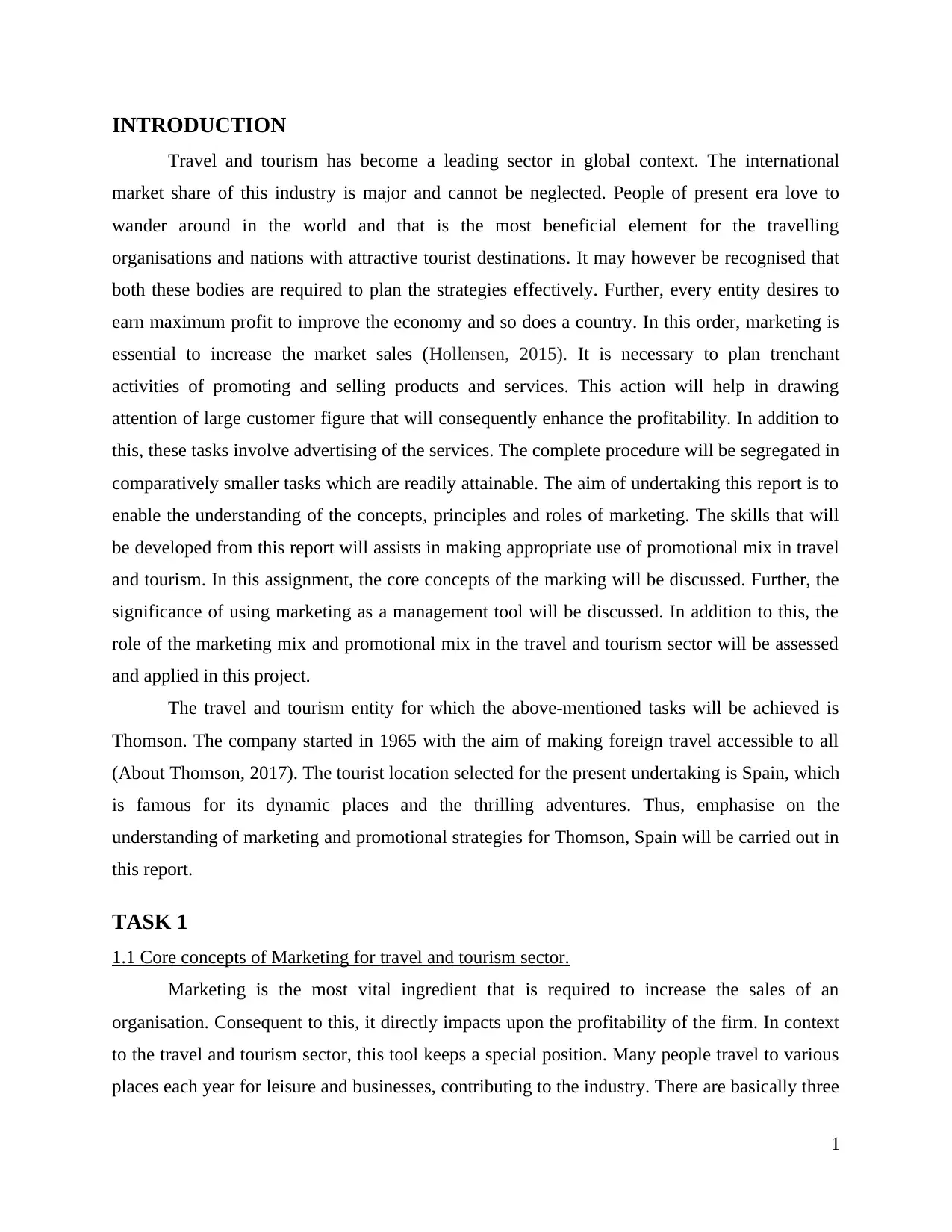
INTRODUCTION
Travel and tourism has become a leading sector in global context. The international
market share of this industry is major and cannot be neglected. People of present era love to
wander around in the world and that is the most beneficial element for the travelling
organisations and nations with attractive tourist destinations. It may however be recognised that
both these bodies are required to plan the strategies effectively. Further, every entity desires to
earn maximum profit to improve the economy and so does a country. In this order, marketing is
essential to increase the market sales (Hollensen, 2015). It is necessary to plan trenchant
activities of promoting and selling products and services. This action will help in drawing
attention of large customer figure that will consequently enhance the profitability. In addition to
this, these tasks involve advertising of the services. The complete procedure will be segregated in
comparatively smaller tasks which are readily attainable. The aim of undertaking this report is to
enable the understanding of the concepts, principles and roles of marketing. The skills that will
be developed from this report will assists in making appropriate use of promotional mix in travel
and tourism. In this assignment, the core concepts of the marking will be discussed. Further, the
significance of using marketing as a management tool will be discussed. In addition to this, the
role of the marketing mix and promotional mix in the travel and tourism sector will be assessed
and applied in this project.
The travel and tourism entity for which the above-mentioned tasks will be achieved is
Thomson. The company started in 1965 with the aim of making foreign travel accessible to all
(About Thomson, 2017). The tourist location selected for the present undertaking is Spain, which
is famous for its dynamic places and the thrilling adventures. Thus, emphasise on the
understanding of marketing and promotional strategies for Thomson, Spain will be carried out in
this report.
TASK 1
1.1 Core concepts of Marketing for travel and tourism sector.
Marketing is the most vital ingredient that is required to increase the sales of an
organisation. Consequent to this, it directly impacts upon the profitability of the firm. In context
to the travel and tourism sector, this tool keeps a special position. Many people travel to various
places each year for leisure and businesses, contributing to the industry. There are basically three
1
Travel and tourism has become a leading sector in global context. The international
market share of this industry is major and cannot be neglected. People of present era love to
wander around in the world and that is the most beneficial element for the travelling
organisations and nations with attractive tourist destinations. It may however be recognised that
both these bodies are required to plan the strategies effectively. Further, every entity desires to
earn maximum profit to improve the economy and so does a country. In this order, marketing is
essential to increase the market sales (Hollensen, 2015). It is necessary to plan trenchant
activities of promoting and selling products and services. This action will help in drawing
attention of large customer figure that will consequently enhance the profitability. In addition to
this, these tasks involve advertising of the services. The complete procedure will be segregated in
comparatively smaller tasks which are readily attainable. The aim of undertaking this report is to
enable the understanding of the concepts, principles and roles of marketing. The skills that will
be developed from this report will assists in making appropriate use of promotional mix in travel
and tourism. In this assignment, the core concepts of the marking will be discussed. Further, the
significance of using marketing as a management tool will be discussed. In addition to this, the
role of the marketing mix and promotional mix in the travel and tourism sector will be assessed
and applied in this project.
The travel and tourism entity for which the above-mentioned tasks will be achieved is
Thomson. The company started in 1965 with the aim of making foreign travel accessible to all
(About Thomson, 2017). The tourist location selected for the present undertaking is Spain, which
is famous for its dynamic places and the thrilling adventures. Thus, emphasise on the
understanding of marketing and promotional strategies for Thomson, Spain will be carried out in
this report.
TASK 1
1.1 Core concepts of Marketing for travel and tourism sector.
Marketing is the most vital ingredient that is required to increase the sales of an
organisation. Consequent to this, it directly impacts upon the profitability of the firm. In context
to the travel and tourism sector, this tool keeps a special position. Many people travel to various
places each year for leisure and businesses, contributing to the industry. There are basically three
1
⊘ This is a preview!⊘
Do you want full access?
Subscribe today to unlock all pages.

Trusted by 1+ million students worldwide
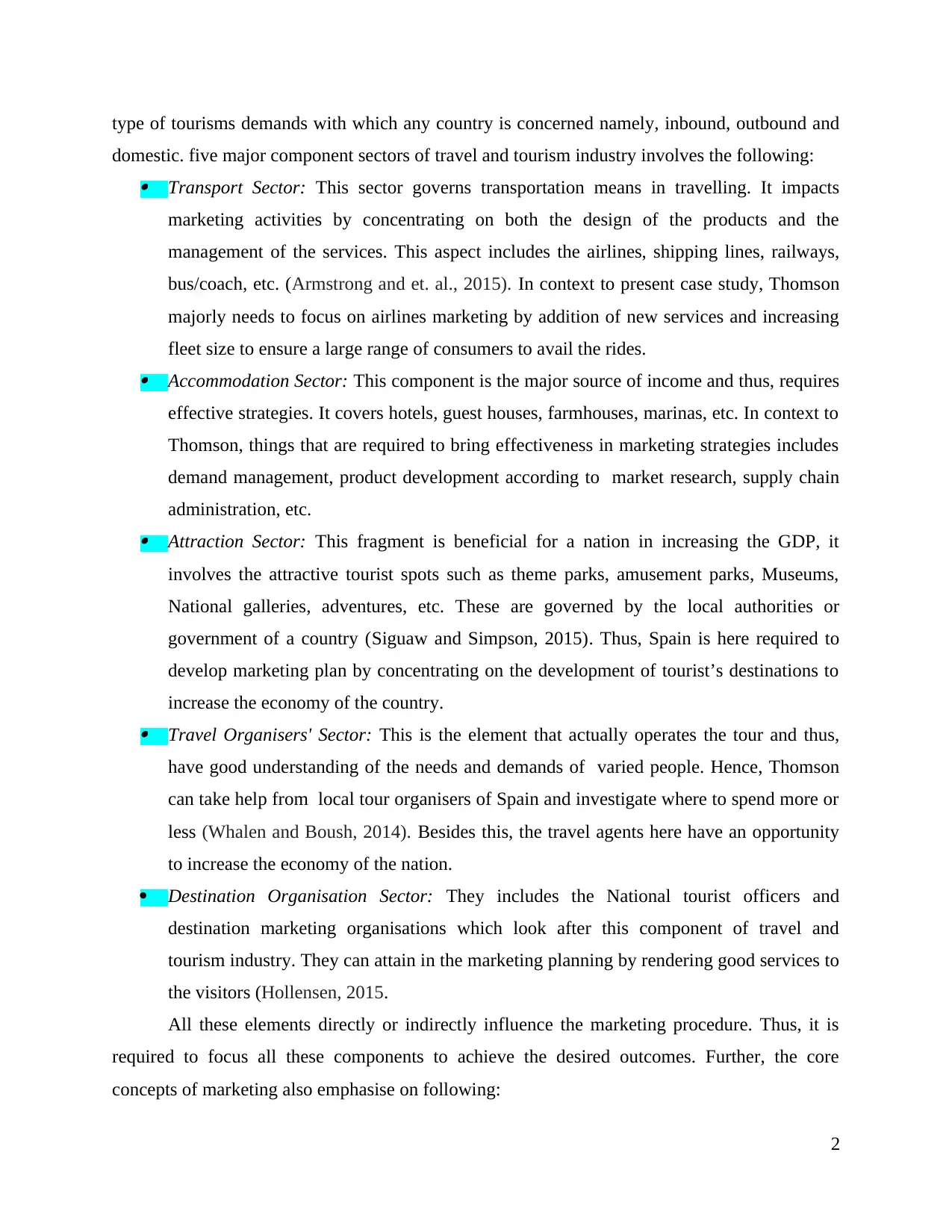
type of tourisms demands with which any country is concerned namely, inbound, outbound and
domestic. five major component sectors of travel and tourism industry involves the following: Transport Sector: This sector governs transportation means in travelling. It impacts
marketing activities by concentrating on both the design of the products and the
management of the services. This aspect includes the airlines, shipping lines, railways,
bus/coach, etc. (Armstrong and et. al., 2015). In context to present case study, Thomson
majorly needs to focus on airlines marketing by addition of new services and increasing
fleet size to ensure a large range of consumers to avail the rides. Accommodation Sector: This component is the major source of income and thus, requires
effective strategies. It covers hotels, guest houses, farmhouses, marinas, etc. In context to
Thomson, things that are required to bring effectiveness in marketing strategies includes
demand management, product development according to market research, supply chain
administration, etc. Attraction Sector: This fragment is beneficial for a nation in increasing the GDP, it
involves the attractive tourist spots such as theme parks, amusement parks, Museums,
National galleries, adventures, etc. These are governed by the local authorities or
government of a country (Siguaw and Simpson, 2015). Thus, Spain is here required to
develop marketing plan by concentrating on the development of tourist’s destinations to
increase the economy of the country. Travel Organisers' Sector: This is the element that actually operates the tour and thus,
have good understanding of the needs and demands of varied people. Hence, Thomson
can take help from local tour organisers of Spain and investigate where to spend more or
less (Whalen and Boush, 2014). Besides this, the travel agents here have an opportunity
to increase the economy of the nation.
Destination Organisation Sector: They includes the National tourist officers and
destination marketing organisations which look after this component of travel and
tourism industry. They can attain in the marketing planning by rendering good services to
the visitors (Hollensen, 2015.
All these elements directly or indirectly influence the marketing procedure. Thus, it is
required to focus all these components to achieve the desired outcomes. Further, the core
concepts of marketing also emphasise on following:
2
domestic. five major component sectors of travel and tourism industry involves the following: Transport Sector: This sector governs transportation means in travelling. It impacts
marketing activities by concentrating on both the design of the products and the
management of the services. This aspect includes the airlines, shipping lines, railways,
bus/coach, etc. (Armstrong and et. al., 2015). In context to present case study, Thomson
majorly needs to focus on airlines marketing by addition of new services and increasing
fleet size to ensure a large range of consumers to avail the rides. Accommodation Sector: This component is the major source of income and thus, requires
effective strategies. It covers hotels, guest houses, farmhouses, marinas, etc. In context to
Thomson, things that are required to bring effectiveness in marketing strategies includes
demand management, product development according to market research, supply chain
administration, etc. Attraction Sector: This fragment is beneficial for a nation in increasing the GDP, it
involves the attractive tourist spots such as theme parks, amusement parks, Museums,
National galleries, adventures, etc. These are governed by the local authorities or
government of a country (Siguaw and Simpson, 2015). Thus, Spain is here required to
develop marketing plan by concentrating on the development of tourist’s destinations to
increase the economy of the country. Travel Organisers' Sector: This is the element that actually operates the tour and thus,
have good understanding of the needs and demands of varied people. Hence, Thomson
can take help from local tour organisers of Spain and investigate where to spend more or
less (Whalen and Boush, 2014). Besides this, the travel agents here have an opportunity
to increase the economy of the nation.
Destination Organisation Sector: They includes the National tourist officers and
destination marketing organisations which look after this component of travel and
tourism industry. They can attain in the marketing planning by rendering good services to
the visitors (Hollensen, 2015.
All these elements directly or indirectly influence the marketing procedure. Thus, it is
required to focus all these components to achieve the desired outcomes. Further, the core
concepts of marketing also emphasise on following:
2
Paraphrase This Document
Need a fresh take? Get an instant paraphrase of this document with our AI Paraphraser

Market: According to this, the customers are interested to invest in the places that are
having the most attractive destinations to wander. Spain being first choice of the visitors,
Thomson group has made some effective holiday packages for this location. Further, a
brochure is also present on the official website that contain all the details of various
packages (Entezari, Karimi, and Kianfar, 2014). Also, one can book a holiday plan from
site too. Further, the attractive locations are enough for Spain to achieve a tag of
favourable market.
Products: They should be according to the needs and demand of the customers to satisfy
them. Considering this, the organisation has planned the package for the people of
different age group, psychological groups, etc. For instance: For youngsters, attractive
adventures are included in the plan and Museum visits, art galleries are involved for
middle age group (Tamura and et. al., 2013). Also, visits to holy places for old aged
people. In context to Spain, a country that has famous cathedral churches, art galleries,
amusement parks, thrilling adventures such as bull race, village hike, sea caving,
horseback riding, rafting, etc. Thus, the range of product in Spain is recommendable.
For the selected organisation Thomson Group marketing will be done for three different
groups of people. They are divided on the basis of their age. It has been considered that interest
of people is highly dependant of age factor. Further, choice of people differs when they are
travelling alone or with family. Hence, considering this, the groups are youngsters, families and
old age.
Group Needs Destination Travel Hotel Transport
Teenagers Adventures,
beaches, etc.
Pyrenees
Mountains,
Montserrat
Monastery and
natural park
hiking,
Barcelona
Natural Park
10 days Marriott's
Marbella
Beach Resort
Ferry
3
having the most attractive destinations to wander. Spain being first choice of the visitors,
Thomson group has made some effective holiday packages for this location. Further, a
brochure is also present on the official website that contain all the details of various
packages (Entezari, Karimi, and Kianfar, 2014). Also, one can book a holiday plan from
site too. Further, the attractive locations are enough for Spain to achieve a tag of
favourable market.
Products: They should be according to the needs and demand of the customers to satisfy
them. Considering this, the organisation has planned the package for the people of
different age group, psychological groups, etc. For instance: For youngsters, attractive
adventures are included in the plan and Museum visits, art galleries are involved for
middle age group (Tamura and et. al., 2013). Also, visits to holy places for old aged
people. In context to Spain, a country that has famous cathedral churches, art galleries,
amusement parks, thrilling adventures such as bull race, village hike, sea caving,
horseback riding, rafting, etc. Thus, the range of product in Spain is recommendable.
For the selected organisation Thomson Group marketing will be done for three different
groups of people. They are divided on the basis of their age. It has been considered that interest
of people is highly dependant of age factor. Further, choice of people differs when they are
travelling alone or with family. Hence, considering this, the groups are youngsters, families and
old age.
Group Needs Destination Travel Hotel Transport
Teenagers Adventures,
beaches, etc.
Pyrenees
Mountains,
Montserrat
Monastery and
natural park
hiking,
Barcelona
Natural Park
10 days Marriott's
Marbella
Beach Resort
Ferry
3
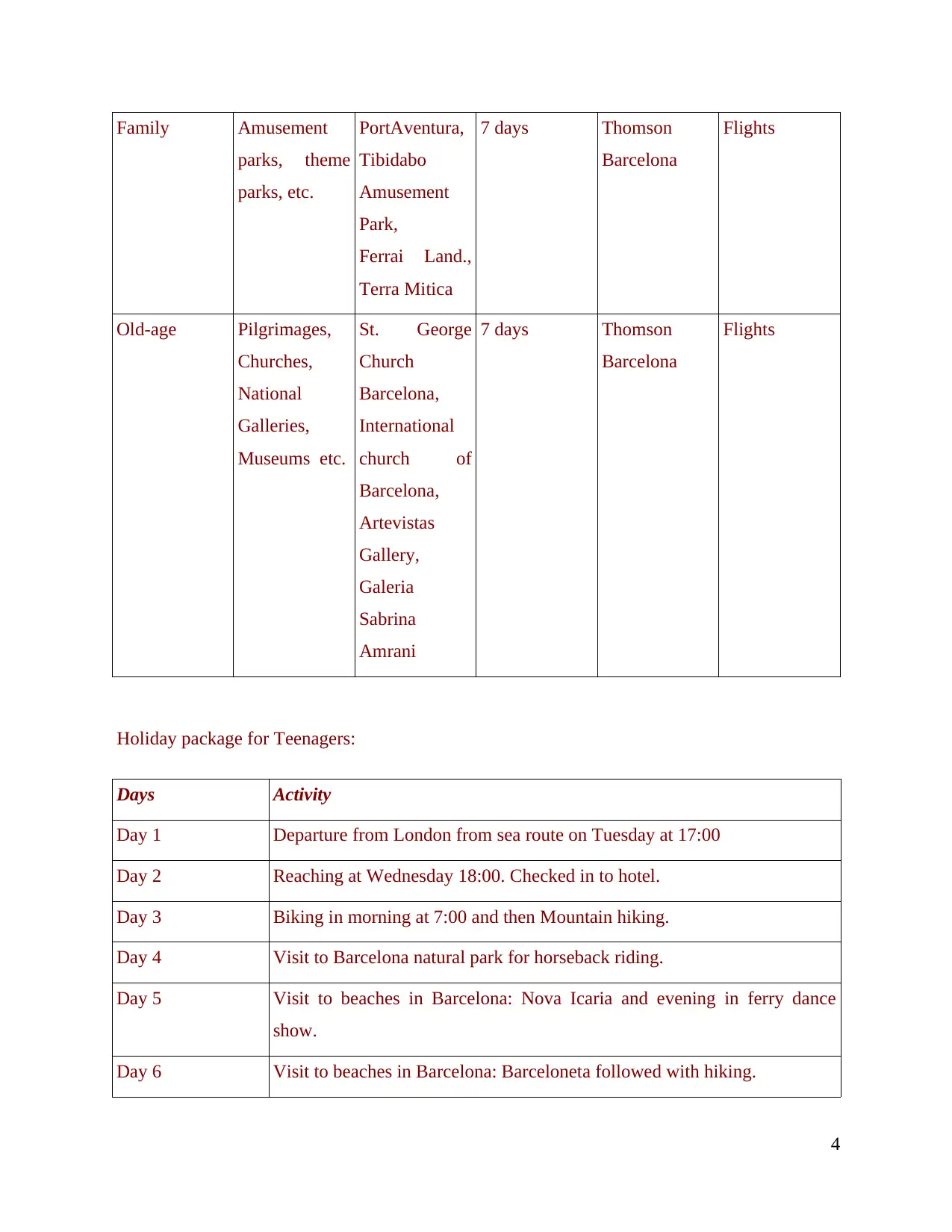
Family Amusement
parks, theme
parks, etc.
PortAventura,
Tibidabo
Amusement
Park,
Ferrai Land.,
Terra Mitica
7 days Thomson
Barcelona
Flights
Old-age Pilgrimages,
Churches,
National
Galleries,
Museums etc.
St. George
Church
Barcelona,
International
church of
Barcelona,
Artevistas
Gallery,
Galeria
Sabrina
Amrani
7 days Thomson
Barcelona
Flights
Holiday package for Teenagers:
Days Activity
Day 1 Departure from London from sea route on Tuesday at 17:00
Day 2 Reaching at Wednesday 18:00. Checked in to hotel.
Day 3 Biking in morning at 7:00 and then Mountain hiking.
Day 4 Visit to Barcelona natural park for horseback riding.
Day 5 Visit to beaches in Barcelona: Nova Icaria and evening in ferry dance
show.
Day 6 Visit to beaches in Barcelona: Barceloneta followed with hiking.
4
parks, theme
parks, etc.
PortAventura,
Tibidabo
Amusement
Park,
Ferrai Land.,
Terra Mitica
7 days Thomson
Barcelona
Flights
Old-age Pilgrimages,
Churches,
National
Galleries,
Museums etc.
St. George
Church
Barcelona,
International
church of
Barcelona,
Artevistas
Gallery,
Galeria
Sabrina
Amrani
7 days Thomson
Barcelona
Flights
Holiday package for Teenagers:
Days Activity
Day 1 Departure from London from sea route on Tuesday at 17:00
Day 2 Reaching at Wednesday 18:00. Checked in to hotel.
Day 3 Biking in morning at 7:00 and then Mountain hiking.
Day 4 Visit to Barcelona natural park for horseback riding.
Day 5 Visit to beaches in Barcelona: Nova Icaria and evening in ferry dance
show.
Day 6 Visit to beaches in Barcelona: Barceloneta followed with hiking.
4
⊘ This is a preview!⊘
Do you want full access?
Subscribe today to unlock all pages.

Trusted by 1+ million students worldwide
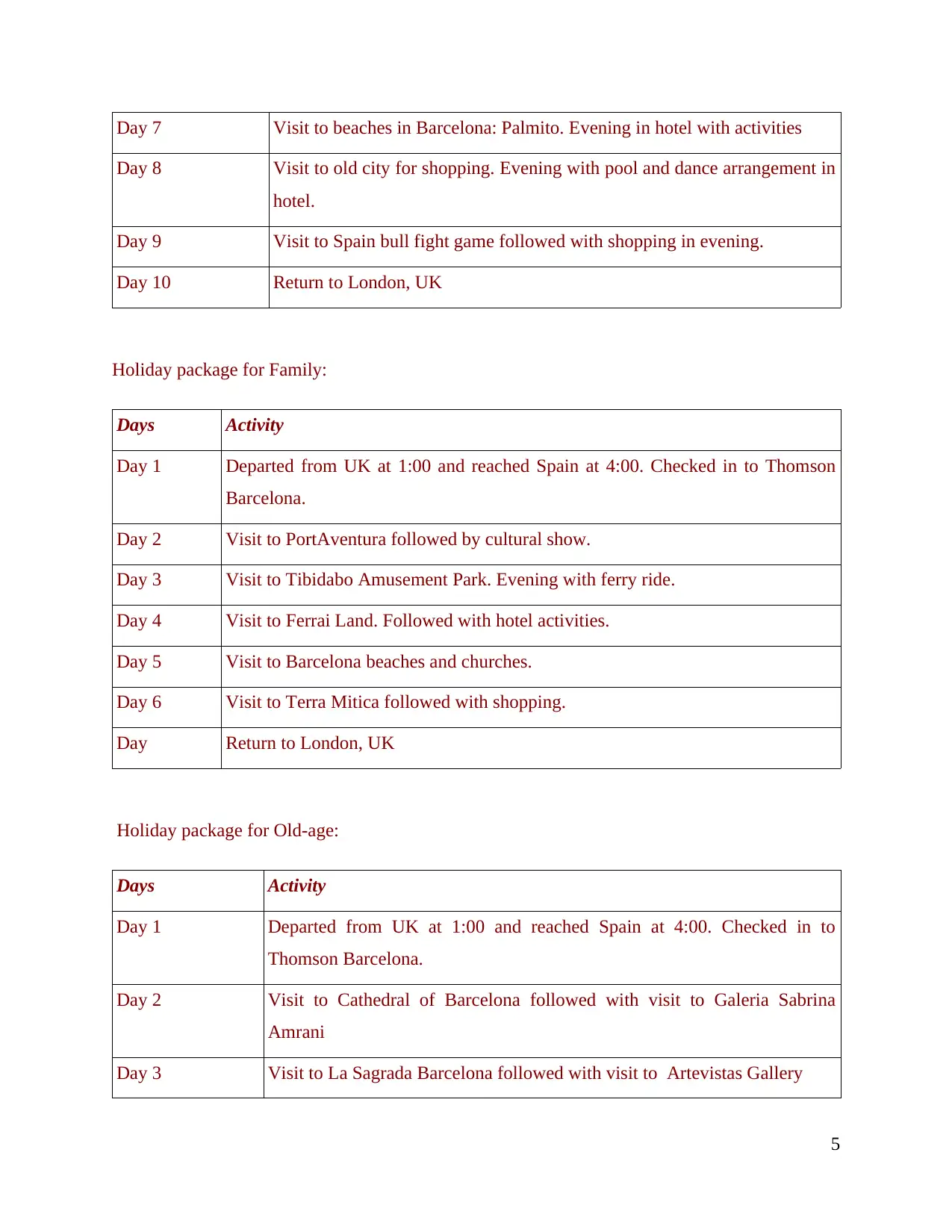
Day 7 Visit to beaches in Barcelona: Palmito. Evening in hotel with activities
Day 8 Visit to old city for shopping. Evening with pool and dance arrangement in
hotel.
Day 9 Visit to Spain bull fight game followed with shopping in evening.
Day 10 Return to London, UK
Holiday package for Family:
Days Activity
Day 1 Departed from UK at 1:00 and reached Spain at 4:00. Checked in to Thomson
Barcelona.
Day 2 Visit to PortAventura followed by cultural show.
Day 3 Visit to Tibidabo Amusement Park. Evening with ferry ride.
Day 4 Visit to Ferrai Land. Followed with hotel activities.
Day 5 Visit to Barcelona beaches and churches.
Day 6 Visit to Terra Mitica followed with shopping.
Day Return to London, UK
Holiday package for Old-age:
Days Activity
Day 1 Departed from UK at 1:00 and reached Spain at 4:00. Checked in to
Thomson Barcelona.
Day 2 Visit to Cathedral of Barcelona followed with visit to Galeria Sabrina
Amrani
Day 3 Visit to La Sagrada Barcelona followed with visit to Artevistas Gallery
5
Day 8 Visit to old city for shopping. Evening with pool and dance arrangement in
hotel.
Day 9 Visit to Spain bull fight game followed with shopping in evening.
Day 10 Return to London, UK
Holiday package for Family:
Days Activity
Day 1 Departed from UK at 1:00 and reached Spain at 4:00. Checked in to Thomson
Barcelona.
Day 2 Visit to PortAventura followed by cultural show.
Day 3 Visit to Tibidabo Amusement Park. Evening with ferry ride.
Day 4 Visit to Ferrai Land. Followed with hotel activities.
Day 5 Visit to Barcelona beaches and churches.
Day 6 Visit to Terra Mitica followed with shopping.
Day Return to London, UK
Holiday package for Old-age:
Days Activity
Day 1 Departed from UK at 1:00 and reached Spain at 4:00. Checked in to
Thomson Barcelona.
Day 2 Visit to Cathedral of Barcelona followed with visit to Galeria Sabrina
Amrani
Day 3 Visit to La Sagrada Barcelona followed with visit to Artevistas Gallery
5
Paraphrase This Document
Need a fresh take? Get an instant paraphrase of this document with our AI Paraphraser

Day 4 Visit to National Gallery followed with activities in hotel.
Day 5 Visit to Museu Picasso and then shopping from local street.
Day 6 Hiking and biking activities at Natural Park, Barcelona.
Day 7 Return to London, UK
1.2 Impact of marketing environment on individual travel and tourism businesses.
Impacts of marketing environment on Thomson:
Micro Environment Factors Customers: This is the most powerful tool that highly effects the marketing. It is thus to
develop the services and products according to the needs and demands of the customers.
For this, effective market research is needed (Entezari, Karimi, and Kianfar, 2014). This
element has the calibre to either made or fade any business.
Suppliers: The major suppliers of the entity include the components that renders
accommodation, transportation, and food facilities. The satisfaction of customers is
totally in their hands (Siguaw and Simpson, 2015). They can gain or lose the trust with
the service and quality of the products.
Macro Environment Factors: Political Factors: The instability in the political conditions of the country affects the
overall marketing procedure (Whalen and Boush, 2014). For instance: If a plan will be
designed according to the policies of the present government then the changes in the
political party will bring some new policies. Consequent to this, the entire strategies will
have to be changed. Further, the political status of the country highly impacts the travel
and tourism business. Economic Factors: This factor puts the biggest impact on the marketing environment of
Thomson. The interest rates, bank rates, growth rates, etc., varies from country to
country. Also, the variance in these data will make the entity to alter the entire plan. This
alteration will result to additional investments. In addition to this, designing of plan
depending upon the specific statistics of the nation is a bit challenging and required
highly skilled employee (Tan and et. al., 2017). The country has the highest economy in
the Europe zone and thus, it is not applicable in the present scenario, However, financial
condition of the travel and tourism company can impact the marketing practices.
6
Day 5 Visit to Museu Picasso and then shopping from local street.
Day 6 Hiking and biking activities at Natural Park, Barcelona.
Day 7 Return to London, UK
1.2 Impact of marketing environment on individual travel and tourism businesses.
Impacts of marketing environment on Thomson:
Micro Environment Factors Customers: This is the most powerful tool that highly effects the marketing. It is thus to
develop the services and products according to the needs and demands of the customers.
For this, effective market research is needed (Entezari, Karimi, and Kianfar, 2014). This
element has the calibre to either made or fade any business.
Suppliers: The major suppliers of the entity include the components that renders
accommodation, transportation, and food facilities. The satisfaction of customers is
totally in their hands (Siguaw and Simpson, 2015). They can gain or lose the trust with
the service and quality of the products.
Macro Environment Factors: Political Factors: The instability in the political conditions of the country affects the
overall marketing procedure (Whalen and Boush, 2014). For instance: If a plan will be
designed according to the policies of the present government then the changes in the
political party will bring some new policies. Consequent to this, the entire strategies will
have to be changed. Further, the political status of the country highly impacts the travel
and tourism business. Economic Factors: This factor puts the biggest impact on the marketing environment of
Thomson. The interest rates, bank rates, growth rates, etc., varies from country to
country. Also, the variance in these data will make the entity to alter the entire plan. This
alteration will result to additional investments. In addition to this, designing of plan
depending upon the specific statistics of the nation is a bit challenging and required
highly skilled employee (Tan and et. al., 2017). The country has the highest economy in
the Europe zone and thus, it is not applicable in the present scenario, However, financial
condition of the travel and tourism company can impact the marketing practices.
6
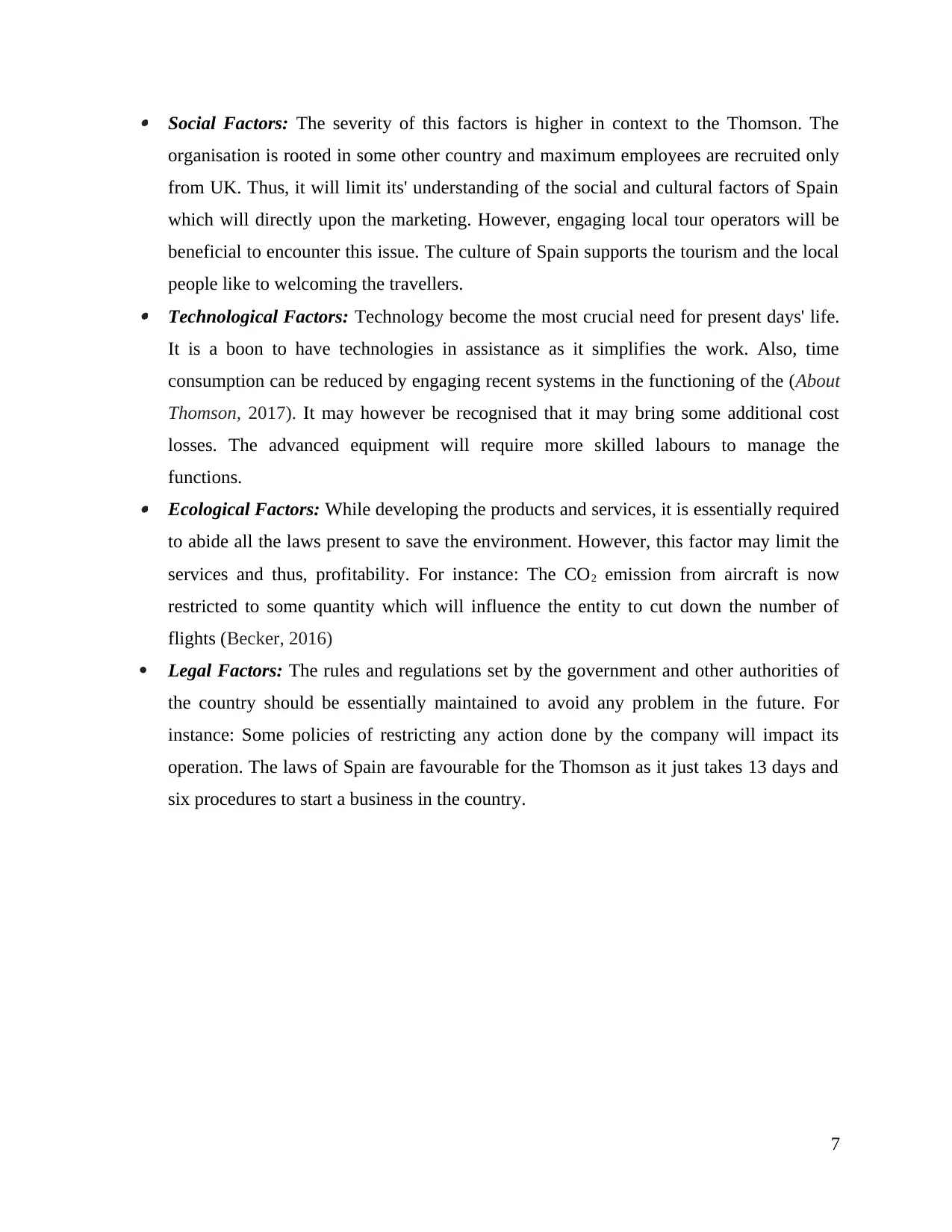
Social Factors: The severity of this factors is higher in context to the Thomson. The
organisation is rooted in some other country and maximum employees are recruited only
from UK. Thus, it will limit its' understanding of the social and cultural factors of Spain
which will directly upon the marketing. However, engaging local tour operators will be
beneficial to encounter this issue. The culture of Spain supports the tourism and the local
people like to welcoming the travellers. Technological Factors: Technology become the most crucial need for present days' life.
It is a boon to have technologies in assistance as it simplifies the work. Also, time
consumption can be reduced by engaging recent systems in the functioning of the (About
Thomson, 2017). It may however be recognised that it may bring some additional cost
losses. The advanced equipment will require more skilled labours to manage the
functions. Ecological Factors: While developing the products and services, it is essentially required
to abide all the laws present to save the environment. However, this factor may limit the
services and thus, profitability. For instance: The CO2 emission from aircraft is now
restricted to some quantity which will influence the entity to cut down the number of
flights (Becker, 2016)
Legal Factors: The rules and regulations set by the government and other authorities of
the country should be essentially maintained to avoid any problem in the future. For
instance: Some policies of restricting any action done by the company will impact its
operation. The laws of Spain are favourable for the Thomson as it just takes 13 days and
six procedures to start a business in the country.
7
organisation is rooted in some other country and maximum employees are recruited only
from UK. Thus, it will limit its' understanding of the social and cultural factors of Spain
which will directly upon the marketing. However, engaging local tour operators will be
beneficial to encounter this issue. The culture of Spain supports the tourism and the local
people like to welcoming the travellers. Technological Factors: Technology become the most crucial need for present days' life.
It is a boon to have technologies in assistance as it simplifies the work. Also, time
consumption can be reduced by engaging recent systems in the functioning of the (About
Thomson, 2017). It may however be recognised that it may bring some additional cost
losses. The advanced equipment will require more skilled labours to manage the
functions. Ecological Factors: While developing the products and services, it is essentially required
to abide all the laws present to save the environment. However, this factor may limit the
services and thus, profitability. For instance: The CO2 emission from aircraft is now
restricted to some quantity which will influence the entity to cut down the number of
flights (Becker, 2016)
Legal Factors: The rules and regulations set by the government and other authorities of
the country should be essentially maintained to avoid any problem in the future. For
instance: Some policies of restricting any action done by the company will impact its
operation. The laws of Spain are favourable for the Thomson as it just takes 13 days and
six procedures to start a business in the country.
7
⊘ This is a preview!⊘
Do you want full access?
Subscribe today to unlock all pages.

Trusted by 1+ million students worldwide

1.3 Factors affecting the motivation and demand of consumer.
Customers are the key elements of the travel and tourism industry. Thus, the entities are
required to attain their satisfaction. It may however be recognised that there are some factors that
impacts upon the consumer motivation and demand. They are as follows: Demographic factors: There are numerous demographic factors such as race, marital
status, gender, age, geographical background, ethnicity, etc. (Becker, 2016). However the
major among them that impacts upon the customer motivation and demand associated
with travel and tourism industries are as follows:
1. Age: People of different age group demands antithetic needs from a tourist location and
tourism industries. If the country will be having those demands of them then the
consumers will get motivated. Also, if the services provided by the entity will fulfil the
expectations of the customers then it will help in gaining their satisfaction (Becker,
2016). For instance: If the country will have amusement parks for children, adventures
8
Illustration 1: PESTLE analysis
Source: (Becker, 2016)
Customers are the key elements of the travel and tourism industry. Thus, the entities are
required to attain their satisfaction. It may however be recognised that there are some factors that
impacts upon the consumer motivation and demand. They are as follows: Demographic factors: There are numerous demographic factors such as race, marital
status, gender, age, geographical background, ethnicity, etc. (Becker, 2016). However the
major among them that impacts upon the customer motivation and demand associated
with travel and tourism industries are as follows:
1. Age: People of different age group demands antithetic needs from a tourist location and
tourism industries. If the country will be having those demands of them then the
consumers will get motivated. Also, if the services provided by the entity will fulfil the
expectations of the customers then it will help in gaining their satisfaction (Becker,
2016). For instance: If the country will have amusement parks for children, adventures
8
Illustration 1: PESTLE analysis
Source: (Becker, 2016)
Paraphrase This Document
Need a fresh take? Get an instant paraphrase of this document with our AI Paraphraser
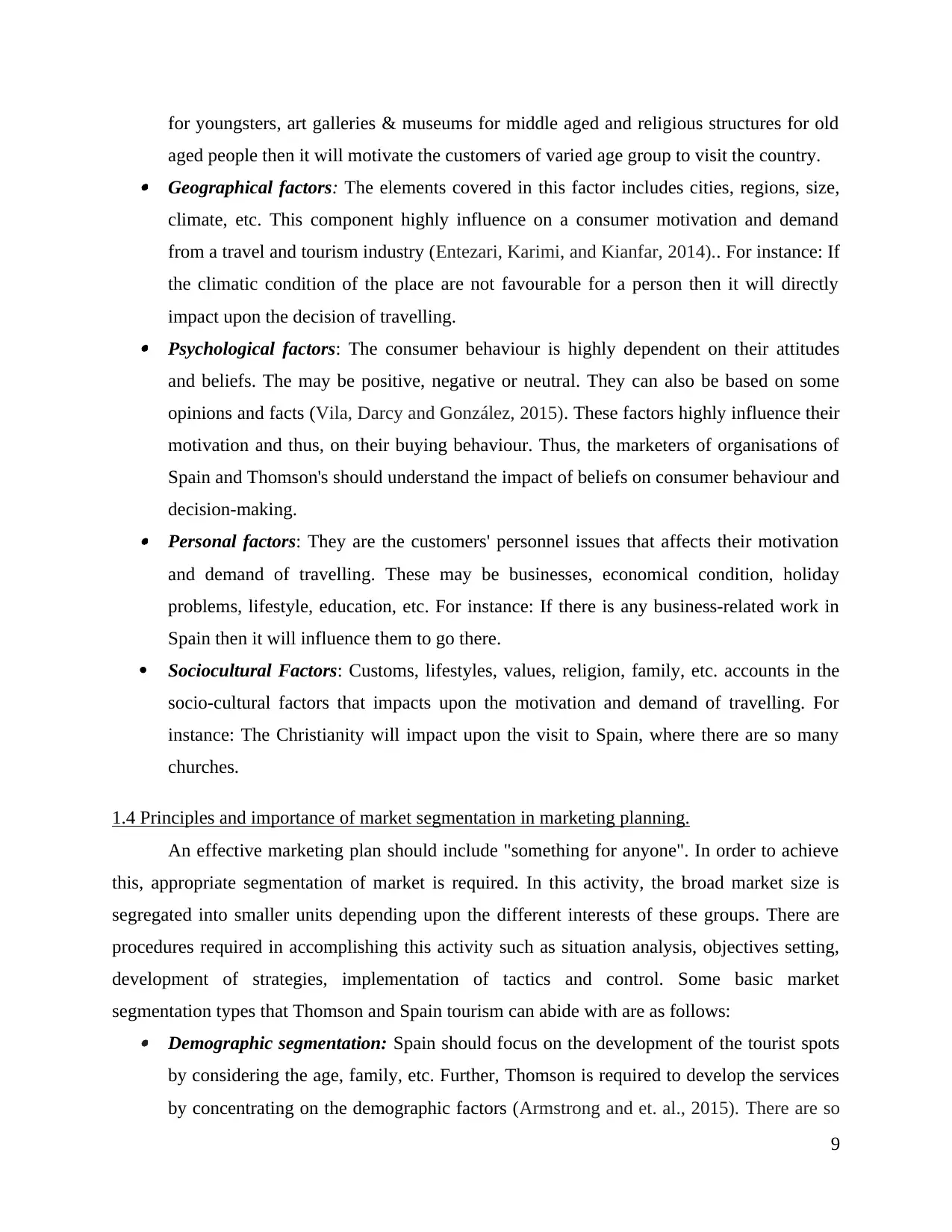
for youngsters, art galleries & museums for middle aged and religious structures for old
aged people then it will motivate the customers of varied age group to visit the country. Geographical factors: The elements covered in this factor includes cities, regions, size,
climate, etc. This component highly influence on a consumer motivation and demand
from a travel and tourism industry (Entezari, Karimi, and Kianfar, 2014).. For instance: If
the climatic condition of the place are not favourable for a person then it will directly
impact upon the decision of travelling. Psychological factors: The consumer behaviour is highly dependent on their attitudes
and beliefs. The may be positive, negative or neutral. They can also be based on some
opinions and facts (Vila, Darcy and González, 2015). These factors highly influence their
motivation and thus, on their buying behaviour. Thus, the marketers of organisations of
Spain and Thomson's should understand the impact of beliefs on consumer behaviour and
decision-making. Personal factors: They are the customers' personnel issues that affects their motivation
and demand of travelling. These may be businesses, economical condition, holiday
problems, lifestyle, education, etc. For instance: If there is any business-related work in
Spain then it will influence them to go there.
Sociocultural Factors: Customs, lifestyles, values, religion, family, etc. accounts in the
socio-cultural factors that impacts upon the motivation and demand of travelling. For
instance: The Christianity will impact upon the visit to Spain, where there are so many
churches.
1.4 Principles and importance of market segmentation in marketing planning.
An effective marketing plan should include "something for anyone". In order to achieve
this, appropriate segmentation of market is required. In this activity, the broad market size is
segregated into smaller units depending upon the different interests of these groups. There are
procedures required in accomplishing this activity such as situation analysis, objectives setting,
development of strategies, implementation of tactics and control. Some basic market
segmentation types that Thomson and Spain tourism can abide with are as follows: Demographic segmentation: Spain should focus on the development of the tourist spots
by considering the age, family, etc. Further, Thomson is required to develop the services
by concentrating on the demographic factors (Armstrong and et. al., 2015). There are so
9
aged people then it will motivate the customers of varied age group to visit the country. Geographical factors: The elements covered in this factor includes cities, regions, size,
climate, etc. This component highly influence on a consumer motivation and demand
from a travel and tourism industry (Entezari, Karimi, and Kianfar, 2014).. For instance: If
the climatic condition of the place are not favourable for a person then it will directly
impact upon the decision of travelling. Psychological factors: The consumer behaviour is highly dependent on their attitudes
and beliefs. The may be positive, negative or neutral. They can also be based on some
opinions and facts (Vila, Darcy and González, 2015). These factors highly influence their
motivation and thus, on their buying behaviour. Thus, the marketers of organisations of
Spain and Thomson's should understand the impact of beliefs on consumer behaviour and
decision-making. Personal factors: They are the customers' personnel issues that affects their motivation
and demand of travelling. These may be businesses, economical condition, holiday
problems, lifestyle, education, etc. For instance: If there is any business-related work in
Spain then it will influence them to go there.
Sociocultural Factors: Customs, lifestyles, values, religion, family, etc. accounts in the
socio-cultural factors that impacts upon the motivation and demand of travelling. For
instance: The Christianity will impact upon the visit to Spain, where there are so many
churches.
1.4 Principles and importance of market segmentation in marketing planning.
An effective marketing plan should include "something for anyone". In order to achieve
this, appropriate segmentation of market is required. In this activity, the broad market size is
segregated into smaller units depending upon the different interests of these groups. There are
procedures required in accomplishing this activity such as situation analysis, objectives setting,
development of strategies, implementation of tactics and control. Some basic market
segmentation types that Thomson and Spain tourism can abide with are as follows: Demographic segmentation: Spain should focus on the development of the tourist spots
by considering the age, family, etc. Further, Thomson is required to develop the services
by concentrating on the demographic factors (Armstrong and et. al., 2015). There are so
9
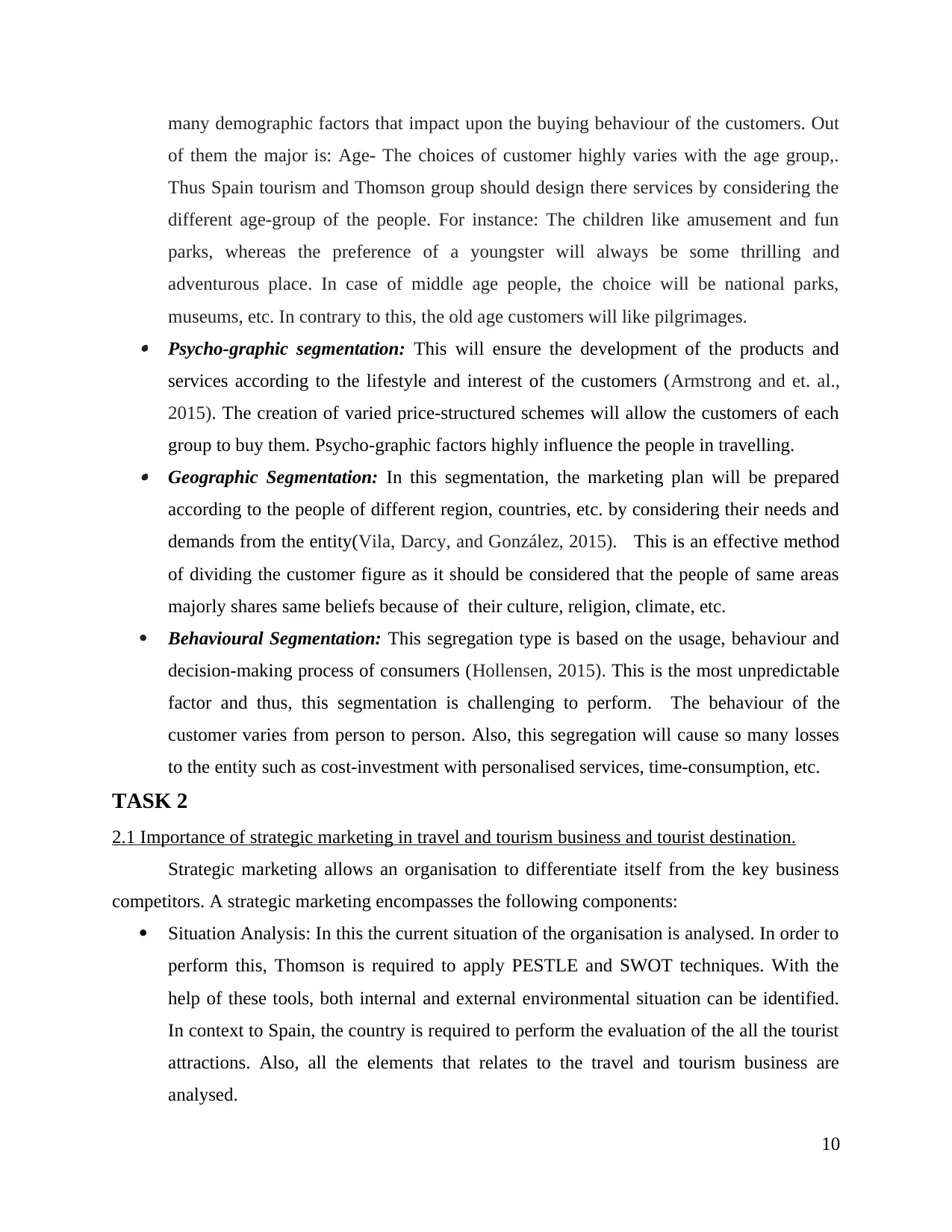
many demographic factors that impact upon the buying behaviour of the customers. Out
of them the major is: Age- The choices of customer highly varies with the age group,.
Thus Spain tourism and Thomson group should design there services by considering the
different age-group of the people. For instance: The children like amusement and fun
parks, whereas the preference of a youngster will always be some thrilling and
adventurous place. In case of middle age people, the choice will be national parks,
museums, etc. In contrary to this, the old age customers will like pilgrimages. Psycho-graphic segmentation: This will ensure the development of the products and
services according to the lifestyle and interest of the customers (Armstrong and et. al.,
2015). The creation of varied price-structured schemes will allow the customers of each
group to buy them. Psycho-graphic factors highly influence the people in travelling. Geographic Segmentation: In this segmentation, the marketing plan will be prepared
according to the people of different region, countries, etc. by considering their needs and
demands from the entity(Vila, Darcy, and González, 2015). This is an effective method
of dividing the customer figure as it should be considered that the people of same areas
majorly shares same beliefs because of their culture, religion, climate, etc.
Behavioural Segmentation: This segregation type is based on the usage, behaviour and
decision-making process of consumers (Hollensen, 2015). This is the most unpredictable
factor and thus, this segmentation is challenging to perform. The behaviour of the
customer varies from person to person. Also, this segregation will cause so many losses
to the entity such as cost-investment with personalised services, time-consumption, etc.
TASK 2
2.1 Importance of strategic marketing in travel and tourism business and tourist destination.
Strategic marketing allows an organisation to differentiate itself from the key business
competitors. A strategic marketing encompasses the following components:
Situation Analysis: In this the current situation of the organisation is analysed. In order to
perform this, Thomson is required to apply PESTLE and SWOT techniques. With the
help of these tools, both internal and external environmental situation can be identified.
In context to Spain, the country is required to perform the evaluation of the all the tourist
attractions. Also, all the elements that relates to the travel and tourism business are
analysed.
10
of them the major is: Age- The choices of customer highly varies with the age group,.
Thus Spain tourism and Thomson group should design there services by considering the
different age-group of the people. For instance: The children like amusement and fun
parks, whereas the preference of a youngster will always be some thrilling and
adventurous place. In case of middle age people, the choice will be national parks,
museums, etc. In contrary to this, the old age customers will like pilgrimages. Psycho-graphic segmentation: This will ensure the development of the products and
services according to the lifestyle and interest of the customers (Armstrong and et. al.,
2015). The creation of varied price-structured schemes will allow the customers of each
group to buy them. Psycho-graphic factors highly influence the people in travelling. Geographic Segmentation: In this segmentation, the marketing plan will be prepared
according to the people of different region, countries, etc. by considering their needs and
demands from the entity(Vila, Darcy, and González, 2015). This is an effective method
of dividing the customer figure as it should be considered that the people of same areas
majorly shares same beliefs because of their culture, religion, climate, etc.
Behavioural Segmentation: This segregation type is based on the usage, behaviour and
decision-making process of consumers (Hollensen, 2015). This is the most unpredictable
factor and thus, this segmentation is challenging to perform. The behaviour of the
customer varies from person to person. Also, this segregation will cause so many losses
to the entity such as cost-investment with personalised services, time-consumption, etc.
TASK 2
2.1 Importance of strategic marketing in travel and tourism business and tourist destination.
Strategic marketing allows an organisation to differentiate itself from the key business
competitors. A strategic marketing encompasses the following components:
Situation Analysis: In this the current situation of the organisation is analysed. In order to
perform this, Thomson is required to apply PESTLE and SWOT techniques. With the
help of these tools, both internal and external environmental situation can be identified.
In context to Spain, the country is required to perform the evaluation of the all the tourist
attractions. Also, all the elements that relates to the travel and tourism business are
analysed.
10
⊘ This is a preview!⊘
Do you want full access?
Subscribe today to unlock all pages.

Trusted by 1+ million students worldwide
1 out of 27
Related Documents
Your All-in-One AI-Powered Toolkit for Academic Success.
+13062052269
info@desklib.com
Available 24*7 on WhatsApp / Email
![[object Object]](/_next/static/media/star-bottom.7253800d.svg)
Unlock your academic potential
Copyright © 2020–2026 A2Z Services. All Rights Reserved. Developed and managed by ZUCOL.





